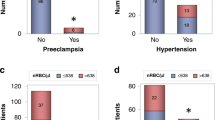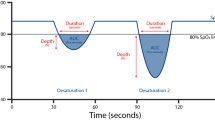Abstract
Tissue hypoxia increases erythropoietin production and release of immature erythrocytes that can be measured using nucleated red blood cell counts (nRBC). We hypothesized that hypoxia due to congenital heart disease (CHD) is chronic and is better tolerated than hypoxia due to respiratory disease (RD), which is an acute stress in newborns leading to higher nRBC. This study assesses the utility of nRBC as a marker to differentiate hypoxia due to CHD vs RD in term neonates. This was a single-center, retrospective study of term neonates with cyanosis from 2015 to 2022. Neonates < 37 weeks of gestation, with hypoxic-ischemic encephalopathy, and those with other causes of cyanosis were excluded. The patients were divided into 2 groups: cyanotic CHD and cyanotic RD. Clinical and laboratory data done within 12 h and 24–36 h after birth were collected. Data are represented as median and Interquartile range. Of 189 patients with cyanosis, 80 had CHD and 109 had RD. The absolute nRBC count at ≤ 12 h of age was lower in the CHD (360 cells/mm3) compared to RD group (2340 cells/mm3) despite the CHD group having significantly lower baseline saturations. A value of 1070 cells/mm3 was highly sensitive and specific for differentiating CHD from RD. The positive predictive value for this cut-off value of 1070 cells/mm3 was 0.94 and the negative predictive value was 0.89. The absolute nRBC is a simple screening test and is available worldwide. A nRBC < 1070 cells/mm3 in cyanotic newborns should hasten the search for CHD etiology with the possible need for prostaglandin therapy.

Similar content being viewed by others
Abbreviations
- CHD:
-
Congenital Heart Disease
- RD:
-
Respiratory Disease
- nRBC:
-
Nucleated Red Blood Cells
- HIE:
-
Hypoxic-Ischemic Encephalopathy
- IQR:
-
Interquartile range
- ROC:
-
Receiver Operating Characteristic
- TGA:
-
Transposition of the Great Arteries
- HLHS:
-
Hypoplastic Left Heart Syndrome
- DORV:
-
Double Outlet Right Ventricle
References
Perrone S, Vezzosi P, Longini M et al (2005) Nucleated red blood cell count in term and preterm newborns: reference values at birth. Arch Dis Child Fetal Neonatal Ed 90(2):F174–F175. https://doi.org/10.1136/adc.2004.051326
Christensen RD, Lambert DK, Richards DS (2014) Estimating the nucleated red blood cell “emergence time” in neonates. J Perinatol 34(2):116–119. https://doi.org/10.1038/jp.2013.113
Widness JA, Schmidt RL, Sawyer ST (1995) Erythropoietin transplacental passage–review of animal studies. J Perinat Med 23(1–2):61–70. https://doi.org/10.1515/jpme.1995.23.1-2.61
Kitanaka T, Alonso JG, Gilbert RD et al (1989) Fetal responses to long-term hypoxemia in sheep. Am J Physiol 256(6 Pt 2):R1348–R1354. https://doi.org/10.1152/ajpregu.1989.256.6.R1348
Phelan JP, Kirkendall C, Korst LM et al (2007) Nucleated red blood cell and platelet counts in asphyxiated neonates sufficient to result in permanent neurologic impairment. J Matern Fetal Neonatal Med 20(5):377–380. https://doi.org/10.1080/14767050701232596
Sawilowsky SS (2005) Misconceptions leading to choosing the T test over the Wilcoxon Mann-Whitney test for shift in location parameter. J Mod Appl Stat Methods 4(2):598–600. https://doi.org/10.22237/jmasm/1130804700
Thilaganathan B, Athanasiou S, Ozmen S et al (1994) Umbilical cord blood erythroblast count as an index of intrauterine hypoxia. Arch Dis Child Fetal Neonatal Ed 70(3):F192–F194. https://doi.org/10.1136/fn.70.3.f192
Widness JA, Teramo KA, Clemons GK et al (1986) Temporal response of immunoreactive erythropoietin to acute hypoxemia in fetal sheep. Pediatr Res 20(1):15–19. https://doi.org/10.1203/00006450-198601000-00004
Eckardt KU, Boutellier U, Kurtz A et al (1989) Rate of erythropoietin formation in humans in response to acute hypobaric hypoxia. J Appl Physiol 66(4):1785–1788. https://doi.org/10.1152/jappl.1989.66.4.1785
Tseng SY, Gao Z, Kalfa TA et al (2022) Altered erythropoiesis in newborns with congenital heart disease. Pediatr Res 91(3):606–611. https://doi.org/10.1038/s41390-021-01370-4
Minior VK, Levine B, Ferber A et al (2017) Nucleated red blood cells as a marker of acute and chronic fetal hypoxia in a rat model. Rambam Maimonides Med J 8(2):e0025. https://doi.org/10.5041/RMMJ.10302
Boskabadi H, Maamouri G, Sadeghian MH et al (2010) Early diagnosis of perinatal asphyxia by nucleated red blood cell count: a case-control study. Arch Iran Med 13(4):275–281
Haiju Z, Suyuan H, Xiufang F et al (2008) The combined detection of umbilical cord nucleated red blood cells and lactate: early prediction of neonatal hypoxic ischemic encephalopathy. J Perinat Med 36(3):240–247. https://doi.org/10.1515/JPM.2008.035
Acknowledgements
We thank Dr. Yaddanapudi Ravindranath for his input on the hematological data.
Funding
This project was done with no financial support.
Author information
Authors and Affiliations
Contributions
Dr DS conceptualized and designed the study, drafted the initial manuscript, collected the data, and critically reviewed and revised the manuscript. Dr YS helped with the study design, collected the data, and critically reviewed and revised the manuscript. Dr RT carried out the initial data analyses and critically reviewed and revised the manuscript. Dr RDR conceptualized and designed the study, coordinated and supervised data collection, and critically reviewed and revised the manuscript for important intellectual content. All authors approved the final manuscript as submitted and agree to be accountable for all aspects of the work.
Corresponding author
Ethics declarations
Conflict of interests
The authors have no conflicts of interest relevant to this article to disclose.
Additional information
Publisher's Note
Springer Nature remains neutral with regard to jurisdictional claims in published maps and institutional affiliations.
We report that nucleated red blood cells (nRBC) can be used as a marker to differentiate a cardiac vs. respiratory etiology of cyanosis at birth.
Rights and permissions
Springer Nature or its licensor (e.g. a society or other partner) holds exclusive rights to this article under a publishing agreement with the author(s) or other rightsholder(s); author self-archiving of the accepted manuscript version of this article is solely governed by the terms of such publishing agreement and applicable law.
About this article
Cite this article
Sahni, D., Sanil, Y., Thomas, R. et al. Nucleated Red Blood Cell Counts Differentiate Cardiac from Respiratory Causes of Cyanosis at Birth. Pediatr Cardiol 45, 513–519 (2024). https://doi.org/10.1007/s00246-024-03409-9
Received:
Accepted:
Published:
Issue Date:
DOI: https://doi.org/10.1007/s00246-024-03409-9




